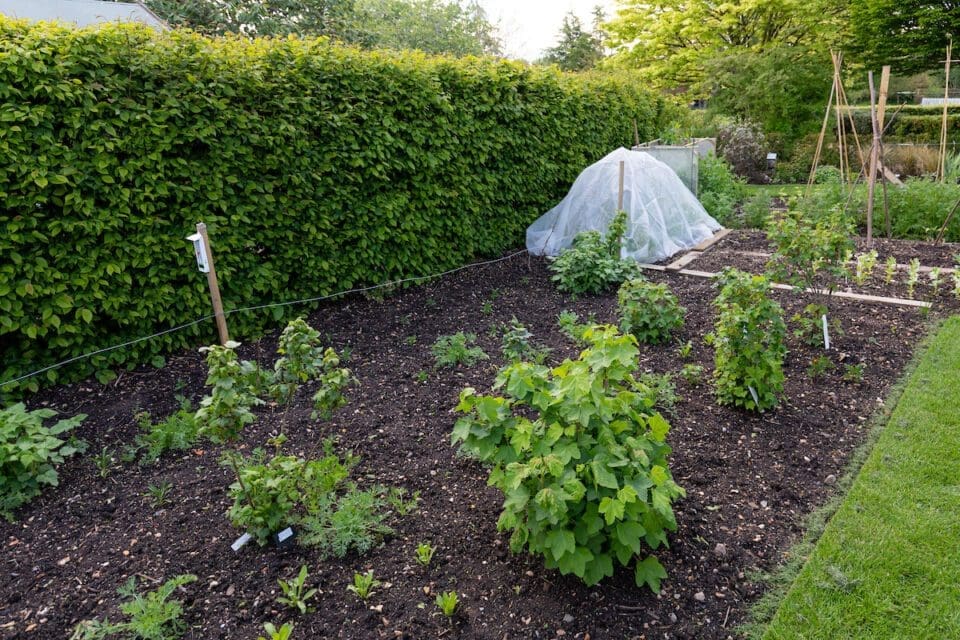Strong winds and storms can be a gardener’s worst nightmare but there are some things you can do to protect your plants from bad weather according to horticultural charity Garden Organic.
It’s 35 years since 15 million trees were estimated to have been lost during the great storm of 1987 that registered hurricane-force gusts of up to 135 mph (217 km/h) causing over £1billion of damage.
Enjoy more Kitchen Garden reading in the monthly magazine.
Click here to subscribe & save.
Many other violent storms have followed, Including Storm Ciara in February 2020 which hit the UK with wind gusts of up to 97mph*. This year, the UK has already experienced Storm Malik with gusts up to 69mph and Storm Corrie with gusts up to 91mh. It is predicted that gardeners will continue to face extreme weather as a result of the climate emergency.
Emma O’Neill, Head Gardener at Garden Organic warns that: “Wind damage can cause havoc in your garden, flattening plants, ripping away branches, drying out foliage, and even uprooting trees. High winds can also stunt the growth of early seedlings and blow over taller bedding plants.
“As gardeners strive to create a more sustainable organic environment in which to encourage wildlife and biodiversity and to soak up carbon from the atmosphere they need to be mindful of how they can protect the soil and their plants from harsh weather extremes such as wind.
“Wind damage can be mitigated by some forward planning of your garden design and by taking emergency short-term measures once severe wind is forecast”.

Ryton Organic Gardens photography May 2021. Picture by Shaun Fellows / Shine Pix Ltd
Emma provides her five top tips for protecting your garden.
- Create permeable wind breaks
o Plant trees and bushes as a wind break around your more delicate planting so that they slow the wind down. This is more effective than fences or walls as these often redirect the wind to elsewhere in the garden.
o Protect your vegetable plot by growing taller produce – such as runner beans, fruit bushes or sun flowers – at the outer edges.
o For balconies, climbing plants wrapped around the railings can act as excellent wind breaks to protect pots and tubs.
o In the flower garden you can plant ornamental windbreaks using bamboo, willow or grasses.
o A trellis or pergola, firmly installed, will also serve to deflect wind and protect your plants. - Choose your planting location carefully
o If your garden slopes, plants in the middle of the slope will be better protected than those at the top or the bottom.
o If possible, plant on the south side of your house to protect against harsh north winds.
o In order to prevent wind rock, where high winds loosen plant roots, make sure shrubs such as roses, buddleia and hydrangeas are planted firmly in the ground - Cover your small and tender plants with cloches.
o This needn’t be costly as you can reuse a plastic bottle. Just cut off the bottom part of the bottle and use the top part to cover the plant. This will create a mini greenhouse trapping heat around the plant. Be sure to push firmly into the ground so it isn’t blown away. - Support tall plants
o Stakes or tall poles should be driven well into the ground as plant supports.
o For some veg such as runner beans and tomatoes arranging the supports in a tepee style will provide a stronger support as well as protection from the wind.
o Climbing plants should be securely tied to trellises but during severe winds you may need to untie them and carefully lay them on the ground until the wind has passed. - Trim plants
o Top heavy plants particularly herbaceous perennials are best trimmed to stop them being easily blown over.
o Reduce the height of shrubs such as a roses and buddleia by a third in the autumn to help protect them from winter winds.
o Any overhanging branches over your green house, polytunnel or public highway should be removed to avoid accidents
Emma adds: “When high winds are forecast it would also be sensible to move pots containing tall plants inside or to a more sheltered spot. Likewise, lightweight garden furniture should be moved into a garage or a secure spot, and polytunnels and green houses should have their doors and windows secured.
“Once Spring comes around you may need to undertake some remedial work by cutting out any damaged foliage from evergreen trees and shrubs. It will also be a good time to assess how well your garden survived any extreme winds and make any necessary improvements for next year.”
Educating gardeners so they can cope with changing weather conditions is a growing part of Garden Organic’s work and the number of requests they receive for advice is growing.
Gardening enthusiasts who are interested in receiving regular organic growing advice can become a member of Garden Organic. They will be able to access a members’ only area of Garden Organic’s website which is packed full of hints and tips on how to grow organically and look after your garden throughout the different seasons. They will receive the members’ Organic Way magazine three times a year and benefit from members’ discounts on gardening courses. Visit: gardenorganic.org.uk/join-us
Further information on growing organically can be found by visiting the Garden Organic website at gardenorganic.org.uk.

A tepee style support will provide wind protection for runner beans and tomatoes
 Enjoy more Kitchen Garden reading in the monthly magazine. Click here to subscribe.
Enjoy more Kitchen Garden reading in the monthly magazine. Click here to subscribe.
Sign-up to the Kitchen Garden Magazine Newsletter
Enter your e-mail address below to see a free digital back issue of Kitchen Garden Magazine and get regular updates straight to your inbox…
You can unsubscribe at any time.
About the Author
- FREE ORGANIC SEEDS WITH YOUR SHOPPING - 24th April 2024
- PRODUCT REVIEWS: PLANTING TOOLS (MAY 24) - 20th April 2024
- RHS Chelsea Flower Show 2024: The Bowel Research UK’s Microbiome Garden - 9th April 2024









